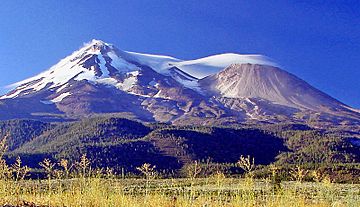Shastina facts for kids
Quick facts for kids Shastina |
|
|---|---|

Mount Shasta and Shastina from the north. Shastina is the satellite cone on the right.
|
|
| Highest point | |
| Elevation | 12,335 ft (3,760 m) NAVD 88 |
| Prominence | 450 ft (140 m) |
| Geography | |
| Location | Siskiyou County, California, U.S. |
| Parent range | Cascade Range |
| Topo map | USGS Mount Shasta |
| Geology | |
| Mountain type | Stratovolcano, satellite cone |
| Volcanic arc | Cascade Volcanic Arc |
| Last eruption | 7420 BCE ± 300 years |
| Climbing | |
| Easiest route | Rock and ice climb |
Shastina is a very tall peak located right next to Mount Shasta in California. It's known as a satellite cone, which means it's like a smaller, connected volcano that grew near a larger one. Shastina is one of four big volcanic cones that together make up the huge stratovolcano of Mount Shasta.
Standing at about 12,335 feet (3,760 meters) high, Shastina is taller than many other mountains. It's even taller than Mount Adams. If it wasn't so close to the even taller Mount Shasta, it would be the third-highest volcano in the Cascade Range. Shastina rises high enough above the land connecting it to Shasta to be considered its own peak by climbers. The name "Shastina" simply means "little Shasta."
Shastina was formed a very long time ago, around 7650 BC. This happened during a large volcanic eruption that also affected the top of Mount Shasta.
Contents
Cool Features of Shastina
Shastina looks like a smooth, cone-shaped mountain with a large, round hole at its top. This hole is about half a mile (0.8 km) wide and is called a crater. But Shastina has some special features that make it stand out from other volcanoes in the Cascade Volcanic Arc.
Diller Canyon: A Giant Groove
One of the most noticeable features is Diller Canyon. This is a huge cut or groove on the western side of the mountain. It was formed by fast-moving flows of hot ash and gas, called pyroclastic flows, that rushed down the volcano. Over time, water and weather have made this canyon even bigger. It stretches from near the crater rim, high up on the mountain, all the way down towards the town of Weed. Diller Canyon is the largest feature of its kind on any of the Cascade volcanoes.
Hidden Crater Lakes
If you climb high up on Shastina, you'll find three small lakes nestled inside its summit crater. These are crater lakes. They are often covered in snow and ice and usually don't melt until late summer.
- Clarence King Lake is in the middle of the crater. It sits at about 11,755 feet (3,583 meters) high.
- Sisson Lake is on the eastern side, a bit higher at about 11,793 feet (3,595 meters).
- The highest lake is unnamed and sits on the south side of a small cinder cone. It's over 11,960 feet (3,645 meters) high.
These lakes are the highest lakes on land in the entire Cascade Range. Only a lake hidden under the ice of Mount Rainier's summit crater is higher.
Climbing and Skiing Adventures
Shastina is a popular spot for climbers and skiers.
Climbing Shastina
The easiest way to climb Shastina is by following a path called the Cascade Gulch route. This path starts from an area called Hidden Valley. It goes diagonally up to the saddle, which is the low point connecting Shasta and Shastina. From there, climbers continue up the eastern side of Shastina's cone to reach its top. For many climbers, visiting Shastina is a quick side trip they take while on their way back from climbing the main Mount Shasta peak.
Skiing Down Shastina
For people who love to ski down mountains, Shastina is a great destination on its own. It offers several amazing ski runs. These include exciting descents down Diller Canyon, the North Face, and the South Face of the mountain.

